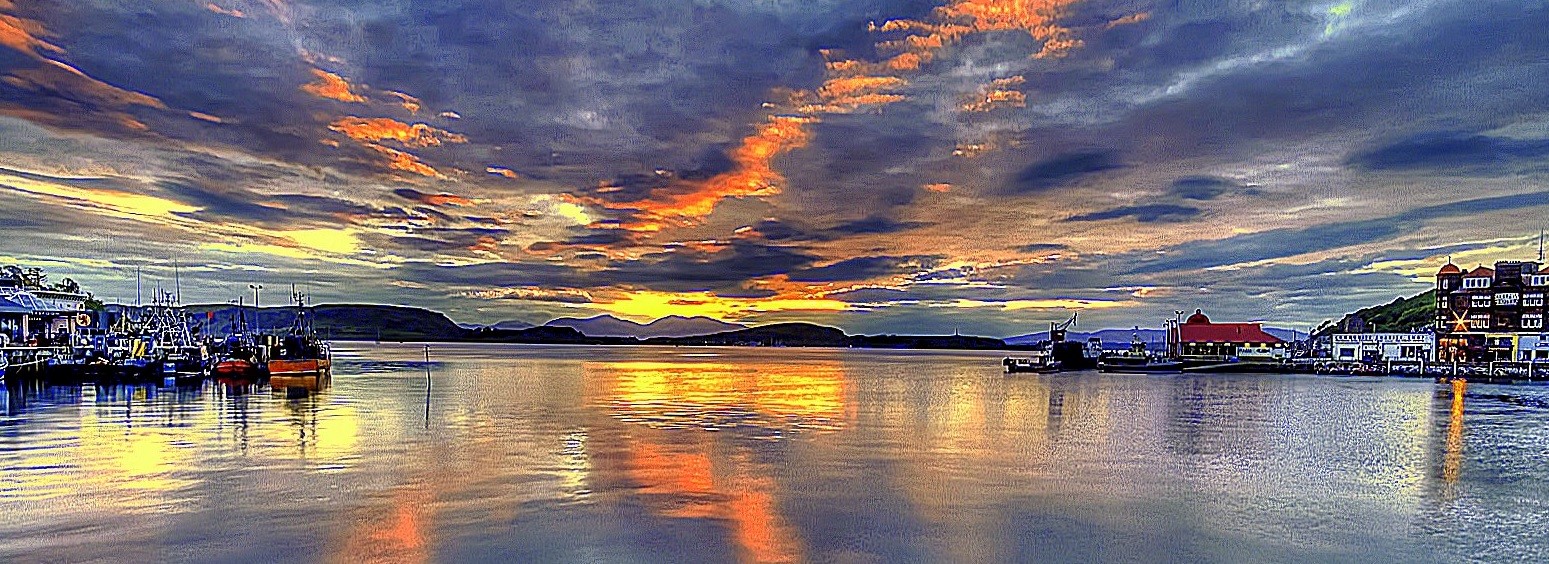More Oban info, I cannee help it!
Oban has been used by humans since at least mesolithic times, as evidenced by archaeological remains of cave dwellers found in the town. Just outside the town stands Dunollie Castle, overlooking the main entrance to the bay, it has been fortified since the Bronze age. Prior to the 19th century, the town had few households, only minor fishing, trading, shipbuilding and quarrying industries, and a few hardy tourists. The Renfrew (Glasgow) trading company established a storehouse in 1714 as a local outlet for its merchandise, a Custom-house was not deemed necessary until 1736 when “Oban being a proper place for clearing out vessels for the herring fishery” was figured out. Oban today grew up around the distillery, founded in 1794. The town was raised to a burgh of barony in 1811 by royal charter. Sir Walter Scott visited in 1814, the year in which he published his poem The Lord of the Isles; interest in the poem brought many new visitors to the town. Oban was made a Parliamentary Burgh in 1833. A rail link – the Callander and Oban Railway – in 1864 but it took years to reach the town. The final stretch of track to Oban opened on 30 June 1880, similar to some of the train schedules of today. This brought further prosperity, revitalising local industry and giving energy to tourism. Also at this time work on the ill-fated Oban Hydro was commenced but abandoned and left to fall into disrepair, after 1882 when Dr Orr, the schemes originator, realised he had grossly underestimated its cost. Work on McCaig’s Tower started in 1895. It was paid for by John Stewart McCaig (1824-1902) and was constructed, in hard times, to give work for local stone masons. However, its construction ceased in 1902 on his death. During World War II, Oban was used by Merchant and Royal Navy ships and was an important base in the Battle of the Atlantic. The Royal Navy had a signal station near Ganavan, and an anti-submarine indicator loop station, which detected any surface or submarine vessels between Oban, Mull and Lismore. There was a controlled minefield in the Sound of Kerrera, which was operated from a building near the caravan site at Gallanach. There was also a Royal Air Force flying boat base at Ganavan and on Kerrera, and an airfield at North Connel built by the Royal Air Force which is still there and in use today. A Sector Operations Room was built near the airfield; after the war, this was extended to become the Royal Observer Corps Group HQ. Oban was also important during the Cold War because the first Transatlantic Telephone Cable (TAT-1) came ashore at Gallanach Bay. This carried the Hot Line between the US Presidents and USSR General Secretaries. At North Connel (near to where I was born), next to the airfield/airport was the NRC (Nuclear Reporting Cell) of the Royal Observer Corps (29 October 1925 to 31 December 1995). Since the 1950s, the principal industry has remained tourism of which I am in, have been for 23 years, the town is also an important ferry port, a hub for Caledonian MacBrayne (calmac) ferries to many of the islands of the Inner and Outer Hebrides. Where I (Paul) was born is another story. Oban’s proximity to the mountains and sea means a wide array of sports are available to visitors and locals, from scuba-diving to coasteering to sailing to mountain biking to winter mountaineering. Other activities of note in the town are: local amateur football team is Oban Saints with a small stadium situated in Mossfield. However, shinty is a more popular game locally, with two major teams, Oban Camanachd and Oban Celtic. The Oban Times runs a “Spot the Shinty Ball” competition each week. Oban Lorne Rugby Football Club turned 50 years old in 2012, and competes in the RBS West region. Oban Golf course was designed by professional golfer James Braid in the early 1900s, and offers a challenging 18 holes across difficult terrain. West Highland Week brings sailors from around the world to the town every year. Scuba diving is also readily available. The wreck diving is spectacular, with the Sound of Mull offering some truly world-class dive sites.
https://www.citypopulation.de/php/uk-scotland.php?cityid=S19001111 This is a really interesting website with population info and much more. Here are some facts about Oban; The Scottish Gaelic name for Oban is An t-Òban, which means The Little Bay. Dunollie Castle occupies a strategic location overlooking the entrance to the bay. The clan was unfriendly to the Macleans. Oban has a resident population of just over 8,500 people (see web link), but during the tourist season it accommodates up to 25,000 people. Oban is home to some of the freshest seafood and award-winning restaurants, Oban deserves its’ title as the ‘Seafood Capital of Scotland’. Oban is the birthplace of several well-known people; contemporary folk musician Aidan O’Rourke, bagpiper Stuart Liddell, artists Charles Avery and Euan Heng, finally Paul McLean born a few miles away in Connel, Old Shore Road.
Susan Newell, the last woman to be hanged in Scotland was from Oban. Oban is twinned with Gorey in County Wexford, Ireland, and Laurinburg in North Carolina, US. Whereas the main city on Stewart Island, New Zealand was named after Oban, thanks to the strong influence of Scottish settlers. A computer glitch on Guy Fawkes Night 2011 ensured the evening went off with a bang as £6,000 of fireworks were ignited simultaneously. The display should have lasted 20-30 minutes. Roman – the football billionaire (Chelsea)and his family recently spent a week enjoying the sights and seafood of Oban, before heading to the South of France.
We offer many tours all over Scotland, many come to Oban, Argyll and Mull, so will you be next? Paul McLean, Perth, 2019.

